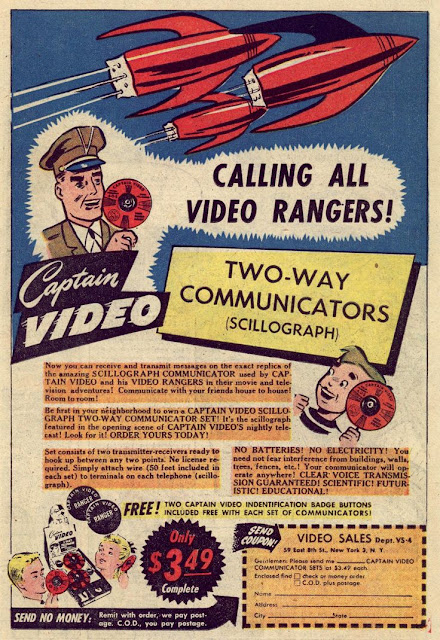 |
| Art by Will Eisner |
The first half of the 20th Century was how humanity found a way to work together to accomplish great deeds. The greatest and most dramatic was to send representatives into outer space, off the globe and into brand new environments. To put people in new and terrible circumstances for the sheer glory and adventure of it. Sure space will ultimately be exploited and its resources turned into capitol, but that's not what triggered the desire to get there. It was different, unknown, and we wanted a taste.
Combine that desire with a society which likes its citizens to fit in comfortably beside one another, and you had the makings of a unifying purpose which drove education and morality to seek to make the population buy into the goal. Captain Video is a strange blend of influences which showcase the contradictions in American society, the simultaneous celebration of the individual alongside the call for a shared cultural mission. A sense of adventure teamed up with a craving for financial reward, a calling linked with a career. These inherently divergent notions were bonded in the space race, a drive ever upward which unified a nation and made the folks at once proud of their nation yet suspicious of their neighbors.
And then it stopped. The goal was achieved to a very modest extent when man finally set foot onto the Moon. After that exalting moment the drive disappeared and was replaced by a cry for moderation and the mood shifted from the Moon to our own monotony. Hard economic times and the always ready individual greed got the better of us and the sense of shared mission vanished as malaise spread. We are still there, more fascinated by ourselves than the universe which expands in all directions beyond us.
Perhaps the weirdest legacy Captain Video has given pop culture was unleashed just last year in the Avengers - Age of Ultron movie.
Roy Thomas makes no bones about how Makino from the pages of the comic inspired the creation of Ultron and after reading the complete story there's little doubt.
So one of the more memorable pop culture villains of recent times derives from the pages of Captain Video and we hardly know it. But that's the case with so much of the influence of this not forgotten but little understood old TV show.
 |
| Another juicy Will Eisner bit of artwork. |
For more on the legacy of Captain Video check this out.
Rip Off








Never seen an episode of Captain Video, but I'm familiar with the name and the fact that it was a TV show because of the parody in one of the early Mad comics.
ReplyDeleteThat was the case with me too until I did the research for this series of posts. The influence of the series was lost on me and I suspect on many who don't even know it informs their daily lives.
DeleteRip Off
A genuinely new environment the country was also launched into at the time was the medium of television. The Kurtzman/Davis parody "Captain TVideo" emphasizes the strangeness and artificiality of early TV, with black and white images that had broadcast interference lines running through it. As usual, Kurtzman has the fake environment disrupted by other realities to jolt the characters out of their complacency. The fact that the character is called Captain Video points to how peculiar and futuristic this new medium seemed at the time. People used to stand outside of store windows to watch early TV broadcasts. It's so much a part of the landscape now, and in fact fallen behind other media, that it's hard to recall how threatening it was to some and how transformative it was to human culture. We live in the 21st century now. This is, politically, socially, scientifically, the future.
ReplyDeleteOutstanding points. I was remiss not to focus on that aspect of the changes in society. In fact TV was a key instrument in the development of a shared cultural identity, cutting edge and modern and as you say potentially dangerous in many respects.
DeleteRip Off